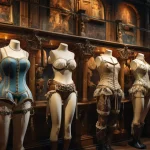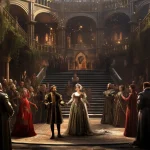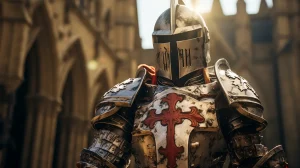
🌟 Unveiling the Mystique of Medieval Attire 🌟
Hey there, fellow fashion history enthusiasts, welcome to a captivating journey through the annals of time and attire. In this immersive exploration, we’re about to embark on a spellbinding voyage into the world of medieval commoners, where clothing was more than just a fabric; it was a mirror reflecting the intricate threads of society’s tapestry.
Picture yourself in a time when grand castles towered over sprawling landscapes, and the hustle and bustle of medieval villages filled the air with life’s vibrant melodies. Yet, our focus isn’t on the nobility within the castle walls; instead, our gaze shifts to the heart and soul of medieval society—the commoners and peasants.
Medieval peasant clothing, a phrase that may conjure images of simplicity and toil, but behind these unassuming garments lay stories of resilience, identity, and the essence of daily life in a bygone era. As we delve deeper into this captivating topic, we’ll unravel the layers of medieval attire, discovering the hidden gems within each tunic, the intricate details that set them apart, and the significance of every stitch.
Are you ready to journey through time and space, guided by the lustrous threads of history? 🕰️👑
🌾 Unveiling the Peasant’s Wardrobe 🌾
As we step further into the realm of medieval commoners, it’s time to turn our gaze towards the heart of their world—their wardrobe. The clothing of medieval peasants was a testament to their practicality, resilience, and the stark realities of their lives.
Tunics: Everyday Comfort
📜 Tunics, the Foundation:
At the core of a medieval peasant’s attire lay the humble tunic. These garments were the very essence of simplicity and functionality. Typically made from durable materials like wool or linen, tunics offered comfort and versatility. Picture earthy tones and natural hues, blending seamlessly with the rustic surroundings.
🎨 The Palette of Simplicity:
Colors were a reflection of available dyes, and peasants predominantly favored earthy shades—warm browns, muted greens, and rustic grays. The focus was on practicality rather than fashion.
Breeches and Footwear: Practicality Meets Utility
👖 Breeches for Mobility:
For men, breeches were a common choice for legwear. Crafted to provide ease of movement, they were often tied at the waist and knees. Imagine a functional design that allowed for the demands of labor in the fields.
👢 Footwear Fit for Work:
Footwear was equally utilitarian. Peasants typically wore sturdy leather or wooden-soled shoes or boots. These were designed to endure long hours of labor and navigate challenging terrains.
Head Coverings and Accessories: Simple Elegance
👒 Head Coverings:
Headwear was essential, especially for women. Picture a simple linen coif or kerchief that shielded them from the elements while working in the fields. These head coverings showcased the fusion of practicality and modesty.
📿 Modest Adornments:
Accessories were minimal but not entirely absent. A leather belt or a basic pouch served both functional and aesthetic purposes. Think of these as subtle details that added a touch of personal expression.
Materials and Craftsmanship: The Essence of Survival
🧵 Crafting the Garments:
Medieval peasants often had to make their own clothing or rely on skilled local artisans. The craftsmanship was simple yet precise, reflecting the importance of long-lasting attire.
🪡 Materials of Necessity:
Wool and linen were the go-to materials due to their availability and durability. These textiles were meticulously cared for and handed down through generations, showcasing the resourcefulness of the medieval commoner.
Visual Insights:
A placeholder image of a medieval peasant’s tunic, made of earthy-toned wool or linen, neatly laid out on a rustic wooden table. The simplicity of the garment reflects the practicality of medieval peasant clothing.
In this section, we’ve journeyed into the heart of medieval commoners’ attire, exploring their tunics, breeches, footwear, head coverings, and accessories. The focus has been on simplicity, functionality, and the enduring craftsmanship that made their clothing a testament to their resilience.
🌾 Everyday Attire for Medieval Commoners 🌾
In the serenity of medieval villages, the common folk went about their daily routines clad in garments that mirrored their way of life. It’s here, amidst the rustic charm of these settlements, that we find the essence of everyday attire for medieval commoners—a blend of practicality, tradition, and cultural expression.
Gender Distinctions: A Subtle Contrast
👗 Women’s Attire:
For women, the attire was defined by simple yet functional dresses or gowns, often made from the same durable materials as men’s clothing. These dresses were designed to provide comfort during long hours of work. Imagine a loose-fitting silhouette with modest necklines and sleeves.
👕 Men’s Attire:
Men’s clothing retained its practicality, featuring tunics and breeches similar to those we explored earlier. However, men might also wear an outer garment, such as a surcoat, which added an extra layer of protection against the elements.
Regional Variations: A Tapestry of Diversity
🌍 Climate and Culture:
The attire of medieval commoners wasn’t a one-size-fits-all affair. It adapted to the climate and cultural nuances of the region. In colder northern regions, for instance, you might find heavier and warmer garments, while in more temperate climates, lighter textiles prevailed.
🎨 Colors and Patterns:
While simplicity reigned supreme, regional variations could be seen in the choice of colors and patterns. These subtle distinctions often bore witness to local traditions and cultural influences.
A Day in the Life: From Farm to Hearth
🌾 Workwear:
During the workday, practicality was paramount. Peasants donned attire that allowed them to toil in the fields or carry out daily tasks with ease. Think of garments that protected against thorns and dirt, built to withstand the rigors of labor.
🍽️ Dressing Up:
Evenings or special occasions called for a change of attire. Commoners might have a slightly more refined outfit for gatherings, such as village fairs or celebrations. These garments were still humble but reflected a sense of community and festivity.
Visual Insights:
A placeholder image showcases a medieval village scene, with men and women in their everyday attire, going about their daily tasks. The women wear simple dresses, and the men don tunics and breeches, embodying the practicality of medieval commoner clothing.
In this section, we’ve delved into the clothing worn by medieval commoners in their daily lives. From gender distinctions to regional variations and the practicality of workwear, we’ve unveiled the attire that defined the essence of their existence.
🌾 The Role of Handwoven Textiles 🌾
In the tapestry of medieval commoner life, one thread stands out as both functional and artistic—the role of handwoven textiles. These intricately crafted fabrics were the cornerstone of medieval peasant clothing, embodying tradition, craftsmanship, and a deep connection to the land.
Handwoven Marvels: Craftsmanship and Creativity
🧵 Artistry in Threads:
Handwoven textiles were at the heart of medieval commoner attire. Imagine artisans diligently working on looms, carefully intertwining threads to create fabrics that were not only durable but also visually captivating. The resulting textiles were a testament to human ingenuity.
🎨 Patterns and Designs:
Patterns and designs on these textiles varied widely. From simple, utilitarian weaves to more intricate motifs, these fabrics spoke of regional identity and cultural influences. Visualize geometric patterns, floral motifs, and occasionally, symbols of luck and protection.
Sourcing Materials: Nature’s Bounty
🌱 Natural Fibers:
Medieval weavers primarily used natural fibers like wool and linen. Wool, sourced from sheep, provided warmth and insulation, making it ideal for the colder months. Linen, derived from flax plants, offered breathability, perfect for the summer heat. Each material had its unique characteristics.
🌿 The Dyeing Process:
Before weaving, fibers needed to be dyed to achieve desired colors. Herbal extracts, roots, and even insects were used to create dyes. Picture vibrant yellows from marigolds, deep blues from woad, and earthy browns from walnut husks.
Every Thread Tells a Story: Symbolism and Significance
🔍 Hidden Meanings:
Handwoven textiles often carried hidden meanings. Patterns and colors could symbolize prosperity, protection, or even ward off evil spirits. These textiles were more than just fabric; they were a form of communication and cultural expression.
Visual Insights:
A placeholder image depicts a skilled weaver at a medieval loom, diligently working on a textile. Surrounding the weaver are colorful spools of thread and various finished fabrics, showcasing the artistry and craftsmanship involved in creating handwoven textiles.
In this section, we’ve unveiled the pivotal role of handwoven textiles in medieval commoner clothing. From the craftsmanship and creativity of artisans to the sourcing of natural materials and the hidden symbolism within each fabric, these textiles were the canvas upon which the story of medieval attire was painted.
⭐ The Significance of Color ⭐
In the realm of medieval commoner attire, color was far from arbitrary. It was a language, a silent communicator, and a window into the world of symbolism and tradition. Let’s dive into the rich tapestry of color significance in the clothing of medieval peasants.
Earthly Tones: A Palette of Practicality
🌿 Natural Shades:
Medieval commoners’ clothing predominantly featured earthy, natural tones. Think of warm browns, muted greens, rustic grays, and gentle blues. These hues weren’t just pleasing to the eye; they were born out of necessity.
🎨 Dyes from Nature:
The colors derived from these fabrics were often the result of natural dyes. Visualize artisans extracting hues from the world around them—marigold for yellow, woad for blue, and madder root for rich reds. The palette was a reflection of the earth’s bounty.
Symbolism in Threads: Hidden Meanings
🔮 Unspoken Language:
Each color had its unique symbolism. For instance, green represented rebirth and renewal, making it a fitting choice for everyday wear. Blue, often associated with the heavens, symbolized protection and hope. Red signified love and passion, while brown conveyed stability and grounding.
💫 Warding off Evil:
Certain colors were believed to ward off malevolent forces. A touch of red or a deep blue, strategically placed in an outfit, could offer protection against supernatural threats, a testament to the superstitions of the era.
Cultural Influence: Regional Variations
🌍 Regional Diversity:
The significance of color wasn’t uniform across medieval Europe. Regional variations influenced color choices. In some areas, a particular color might be associated with local traditions or beliefs. Diversity in clothing was an expression of the diverse cultures that thrived across the continent.
Visual Insights:
A placeholder image showcases a collection of hand-dyed fabric swatches, each representing a different color commonly used in medieval peasant clothing. The swatches are arranged in a visually appealing pattern, allowing readers to visualize the richness of colors in commoner attire.
In this section, we’ve unveiled the hidden language of color in medieval peasant clothing. From the practicality of earthly tones to the symbolism in threads and regional variations, color played a profound role in the attire of these bygone times.
🌟 Adorning Elegance: Clothing Accessories and Adornments 🌟
In the enchanting world of medieval commoner attire, simplicity met elegance in the form of accessories and adornments. These subtle yet meaningful additions complemented the practicality of everyday clothing, adding a touch of charm and personality.
Belts: Form and Functionality
🩰 Waist Adornments:
At the waist, a leather belt was a common sight. It wasn’t just about holding garments in place; it was an opportunity for personal expression. Picture a simple leather belt with a rustic buckle, a hint of character amidst the practicality.
Head Coverings: Modesty and Tradition
👒 Linen Coifs:
For women, a linen coif or kerchief served both modesty and practicality. These head coverings shielded them from the sun and wind while working in the fields. Visualize a linen coif, neatly tied under the chin, framing the face with a touch of understated elegance.
Pouches: Carrying Life’s Essentials
👜 Leather Pouches:
Leather pouches, often attached to belts, were a common accessory for both men and women. These pouches carried essential items—a small knife, a piece of dried herbs, or even a small keepsake. They were functional, personal, and discreet.
Visual Insights:
A placeholder image portrays a rustic leather belt with a simple yet intricately designed buckle. Next to it, a linen coif rests gracefully, and a leather pouch dangles from a belt. The image captures the essence of medieval commoner accessories, combining form and function.
In this section, we’ve explored the world of accessories and adornments in medieval commoner attire. From belts as a form of self-expression to head coverings for modesty and leather pouches for practicality, these subtle details added a layer of charm to the simplicity of everyday clothing.
🍃 Embracing the Seasons: Seasonal Changes in Attire 🍂
In the medieval world, the changing seasons dictated more than just the landscape; they influenced the very fabric of daily life. Let’s journey through the wardrobe of medieval commoners as they adapted their attire to the whims of Mother Nature.
Winter Wardrobe: Battling the Cold
❄️ Woolen Warmth:
As winter’s chill descended, medieval peasants turned to woolen garments for insulation. Visualize thick woolen tunics and cloaks that provided a cozy shield against the biting cold. These were the practical choices for keeping warm during harsh winters.
🌬️ Layering for Comfort:
Layering was key during winter months. Peasants added additional clothing beneath their tunics, creating a thermal barrier against the elements. Multiple layers of warmth made daily chores more bearable.
Summer Simplicity: Beating the Heat
☀️ Lighter Linen:
As the temperature soared, lighter materials like linen took center stage. Linen tunics and breeches offered breathability, ensuring comfort in the summer heat. Imagine loose-fitting attire that allowed for better airflow.
🌾 Simplicity Rules:
During the summer, practicality triumphed over adornment. Simplicity was key, and the focus remained on staying cool and comfortable while tending to fields and daily tasks.
Transitional Attire: Seasons in Flux
🍁 The In-Between Months:
Spring and autumn brought transitional weather. Peasants adjusted their clothing accordingly. Imagine layering woolen tunics over linen ones during cooler spring mornings or evenings.
Visual Insights:
A placeholder image captures the essence of seasonal attire, with side-by-side depictions of a medieval peasant in both winter and summer clothing. The contrast between the thick woolen attire and the lighter linen garments visually represents the adaptability of medieval attire to changing seasons.
In this section, we’ve embraced the seasons alongside medieval commoners, exploring how they adapted their attire to cope with the challenges posed by nature. From winter’s woolen warmth to the breezy simplicity of summer, clothing was a reflection of practicality and necessity.
👑 Influence of Social Status: Dressing the Class Divide 👑
In the captivating tapestry of medieval life, attire wasn’t just about protection and modesty; it was a visual cue to one’s place in society. Let’s delve into the intricate world of medieval commoner clothing and how it subtly reflected social hierarchies.
Peasant Class: Simple Practicality
🌾 Humble Attire:
For the vast majority of medieval commoners, clothing was a matter of necessity. Peasants, who formed the backbone of society, wore practical attire designed for hard labor. Picture simple tunics, basic breeches, and functional footwear. Adornments were minimal, and earthy tones prevailed.
👢 Footwear: Sturdy and Sensible:
Peasant footwear was geared towards durability and protection. Leather shoes or boots were the norm, ensuring the ability to navigate rugged terrain and long hours of labor.
Craftsmen and Artisans: A Touch of Creativity
🔨 Artistry in Clothing:
Craftsmen and artisans, while still commoners, often displayed a touch more creativity in their attire. Their clothing might feature subtle embellishments or more intricate designs. These elements celebrated their craftsmanship and skill.
Local Variation: Regional Flavors
🌍 Cultural Influences:
Across medieval Europe, regional variations in attire were influenced by local customs and traditions. Even within the commoner class, subtle differences in clothing could signify one’s place of origin or cultural heritage.
Visual Insights:
A placeholder image depicts a group of medieval commoners, each dressed according to their social status. Peasants wear simple, practical attire, while craftsmen and artisans exhibit slightly more embellished clothing. The image highlights the subtle nuances that defined social hierarchies.
In this section, we’ve uncovered how social status influenced the attire of medieval commoners. From the humble garb of peasants to the more creative clothing of craftsmen, attire served as a silent indicator of one’s place in society.
✂️ The Art of Handmade Clothing: Craftsmanship and Creativity ✨
In the realm of medieval commoner attire, the term “handmade” wasn’t just a description; it was a testament to the artisanal craftsmanship that went into creating every garment. Let’s step into the world of handmade clothing and discover the meticulous artistry behind each stitch.
Crafting with Care: The Tailor’s Skill
✂️ Tailoring Excellence:
Medieval tailors were the unsung heroes of fashion, working diligently to craft garments that fit perfectly and showcased the wearer’s individuality. Visualize a tailor’s workshop, filled with bolts of fabric, spools of thread, and skilled hands at work.
Customization: Personal Touches
🎨 Individual Expression:
Handmade clothing allowed for a level of customization that mass-produced garments couldn’t match. Customers could request specific details, from the cut of a neckline to the choice of embellishments. Imagine a simple tunic transformed into a unique work of art.
Embellishments and Adornments: Artistic Flair
✨ Decorative Elements:
Artistic flair often found expression through embellishments. Hand-embroidery, intricate weaving, and carefully placed adornments added character and beauty to otherwise practical attire. Picture delicate floral patterns or symbolic motifs.
Visual Insights:
A placeholder image showcases a medieval tailor’s workspace, complete with bolts of fabric, scissors, and a tailor meticulously working on a garment. The image captures the essence of craftsmanship and the dedication that went into creating handmade clothing.
In this section, we’ve delved into the world of handmade clothing in medieval times. From the skill of tailors to the personalized touches and artistic embellishments, handmade garments were a fusion of practicality and creative expression.
👞 The Evolution of Footwear: From Function to Fashion 👠
The journey through medieval commoner attire wouldn’t be complete without stepping into the world of footwear. From humble beginnings as practical necessities, shoes evolved to become both functional and fashionable. Let’s explore the fascinating evolution of medieval footwear.
Bare Necessities: Early Foot Coverings
🦶 Simple Beginnings:
In the earliest medieval times, many commoners went barefoot or wore rudimentary foot coverings made from animal hides. Picture leather wraps or simple sandals, designed primarily for protection against rough terrain.
Functional Footwear: Protection and Durability
👢 Leather and Simplicity:
As medieval life became more structured, so did the need for better footwear. Leather shoes and boots became common, offering protection from cold, wet, and rugged terrain. Visualize sturdy leather boots, laced up for a secure fit.
Fashion Creeping In: Style Emerges
🌟 The Influence of Style:
Over time, even functional footwear started to exhibit touches of style. Imagine subtle decorative elements like etched patterns or small buckles. These additions hinted at the emergence of fashion-conscious commoners.
Regional Variations: Cultural Flair
🌍 Regional Styles:
Just as attire varied across regions, so did footwear. Different cultures and climates gave rise to diverse styles of shoes. From the wooden clogs of northern Europe to the pointed shoes of the East, footwear was a reflection of local influences.
Visual Insights:
A placeholder image showcases a pair of medieval leather boots, highlighting the durability and craftsmanship that went into their creation. The image also hints at the subtle decorative details that marked the transition from pure function to a fusion of function and fashion.
In this section, we’ve traced the evolution of medieval footwear, from humble beginnings to the emergence of style and regional variations. Footwear, once a bare necessity, evolved into a statement of function and fashion.
👗 Reflecting on the Rich Tapestry of Medieval Commoner Attire 🎉
As we bid farewell to our exploration of medieval commoner attire, it’s time to reflect on the fascinating journey we’ve embarked upon. From the simplicity of everyday clothing to the intricate details of accessories, and from the influence of social status to the artistry of handmade clothing, our voyage through time has been nothing short of enchanting.
The Weave of Daily Life:
Every garment we’ve encountered, from the basic tunics of peasants to the creatively adorned attire of craftsmen, tells a story. It speaks of practicality, of functionality, and of the enduring human desire for self-expression.
Seasons, Social Strata, and the Human Spirit:
We’ve uncovered how the changing seasons influenced attire, how social status left subtle imprints on clothing choices, and how the human spirit found ways to infuse creativity into even the most practical aspects of life.
Craftsmanship and Evolution:
The craftsmanship behind handmade clothing has shown us that even in the most utilitarian of tasks, there is room for artistry. Footwear has evolved from mere protection to a fusion of function and fashion, reflecting the ever-changing tapestry of human needs and desires.
A Visual Feast:
Throughout our journey, we’ve seen glimpses of the past through carefully curated images. These visual insights have enriched our understanding of medieval commoner attire, allowing us to immerse ourselves in the world of bygone eras.
Our Time-Travel Ends Here:
As we conclude this expedition, I hope you’ve gained a deeper appreciation for the clothing that enveloped the lives of medieval commoners. Their attire, once a reflection of necessity, has become a window into the past—a past where function and fashion, simplicity and creativity, intertwined to weave the rich tapestry of life.
Thank you for joining me on this captivating journey through the annals of fashion history. Until our next adventure!








